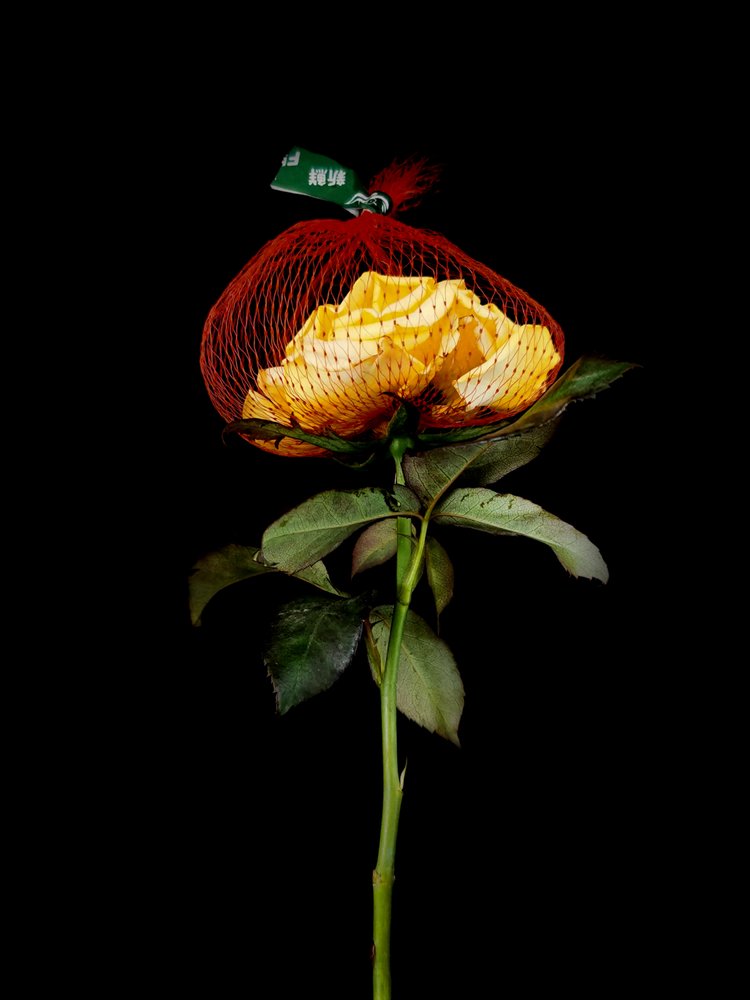





Your 'Metamorphose' series is particularly captivating as it surrealistically manipulates the floral and found object into recognizable totems: the scorpion, the crayfish, etc.
What influences shaped this body of work?
I have always found it interesting to photograph fish, and since flora is my main subject, I thought about mixing them.
The fins turn into petals, the scales into stone and rhinestones, the tail into tropical leaves.
This way, the series becomes a study on genetic modification.
My influences are surrealism of course, the imagination of Jules Vernes, the illustrations of Ernst Haeckel, the iconographic work of Bjork, the incredible clothes of Noir Kei Ninomiya.
I like this way of transcending the elements of nature.
In 'Metamorphose', there's a repetition of vibrant flowers meets sparkling gems / diamanté - adding a sort of performance feel.
Even the fish posed as subjects appear like stars of some sort of show!
Does your photographic practice coincide with threads taken from different art forms?
Yes, I like to make use of techniques and items such as embroidery, jewels and pieces of plastic deformed by fire.
I am a multidisciplinary artist and all these extra pieces add a surreal and unreal effect, from another dimension.
The jewellery pieces are for me like molecules, particles, energies, small fluorescent details that have been seen underwater, inside waves.


Tell us about your venture into photography.
When did it start? What encouraged you to take photos?
Whose works do you admire?
I started to approach photography when I was 20, during my fine art studies in Paris. I won photo contests, worked for magazines (Liberation, photo magazines, etc.) and was selected by the Arles Festival as a young talent in 1985.
Then I had a big interruption.
Another country, another lifestyle, another job and my family.
I resumed, years later, during the pandemic: 1 photo per day.
My common thread was nature, plants, flowers and my relationship with them.
What is your process with photography?
Is it a spontaneous process or do you research and plan extensively before shooting?
It is a fairly slow process.
The first step is meditation. Often I have channels, images appear to me. I store them in my mind, then I concretize my visuals by making a sketch.
I build my jewellery elements, I go out into nature to look for my flowers, and pick them in the wild. After that, I construct my subject like a sculpture.
To do this, I use scalpels and my installation becomes a veritable surgery and precision room.
There is no photomontage and just very basic editing touches on colours and backgrounds. My still life photos are taken with my Huawei Phone which I chose for its Leica Lens, while for my photos with models I use a Sony Alpha camera.
In 'No Nature No Future', similar to 'Metamorphose' in the use of contrasting black against the vibrancy of the object, there's an interesting juxtaposition of the man-made vs. the organic, tell us what motivated you to create these images?
Living in Bali, we are often confronted with a lush nature which is unfortunately spoiled by the greatest scourge of the century: plastic. Organic meets plastic. I found it very interesting to develop this subject to raise awareness of this problem.
We see that you're from France but have truly moved around a lot!
Sénégal, Martinique, South-West of France, Paris, Italy and Bali have all been called homes at some stage. Can you tell us more about how this experience of living between such diverse places has affected the way you approach image-making? Do you feel that your series' focuses predominantly on the organic as you've seen environmental change across the different landscapes and consequential social issues?
Having lived in different countries gave me an open mind.
It influenced my taste.
I have lived in very heterogeneous universes: my grandmothers’ rooms with Louis XV and Empire furniture and upholstery, all blended in my taste and style with memories of Dakar when I was young - colours, spices, perfumes, sounds.
So I like to mix baroque with indigenous, romantic with punk, porcelain with plastic. I love contrasts and paradoxes.

How do you feel about the social environment you're living in (with regards to environmental protection)?
Does it make you feel optimistic or helpless?
There is a lot to be done for the protection of the environment.
Things are moving but still too slow.
A few years ago, two young Indonesian girls succeeded in having plastic bags banned in supermarkets in Bali.
A great victory.
The Balinese are doing more and more beach and river clean ups. Gradually, there is awareness and we are moving in the right direction with more and more permaculture helping farmers to grow organic crops.
Fortunately, there are also committed artists and complexes - with a very contemporary but organic and sustainable architecture - that are honing in on and building within nature to give birth to a new world.






